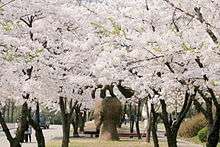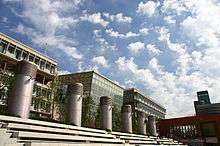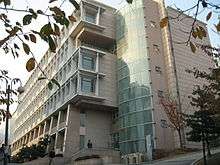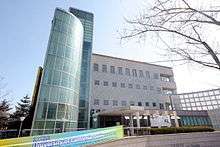Kookmin University
| 국민대학교 | |
 | |
| Motto | 이교위가 (以校爲家) |
|---|---|
Motto in English | C3 (Change, Chance, Challenge) |
| Type | Private |
| Established | September, 1946 |
| Chairman | Chaegyeom Kim |
| President | Jisoo Yu |
Academic staff | 1,702 (2014) |
Administrative staff | 463 (2014) |
| Undergraduates | 15,493 (2014) |
| Postgraduates | 2,731 (2014) |
| Location |
Seongbuk-gu, Seoul, South Korea |
| Campus | Urban |
| Mascot | Two Dragons |
| Website |
english.kookmin.ac.kr (English) www.kookmin.ac.kr (Korean) |
 | |
| Kookmin University | |
| Hangul | 국민대학교 |
|---|---|
| Hanja | 國民大學校 |
| Revised Romanization | Gukmin Daehakgyo |
| McCune–Reischauer | Kukmin Taehakkyo |
Kookmin University (hangul:국민대학교, hanja:國民大學校) is the first national private university located in Seongbuk-gu, Seoul, South Korea after the liberation of the Republic of Korea from Japan. Kookmin University was established in 1946. After South Korea was liberated from Japan, Gu kim, Soang Jo and Ikhee Shin who are the members of the cabinet in a provisional government had agreed to cultivate a great leader among the Republic of Korea in perspective, which soon became the banner of the Kookmin University. Ikhee Shin who is one of the key figures of establishment for the Kookmin University was inaugurated as the first president of the University. Kookmin University is owned by the SsangYong Group, which bought the university in 1959.
Kookmin University has an academic family of 22,000 students, about 800 faculty members and 350 administrative staff. Since its establishment in 1946, approximately 60,000 students have graduated.
Kookmin University includes the College of Humanities, the College of Engineering and 12 other colleges. The university includes a Graduate school which consists of three Professional Graduate Schools and ten Special Graduate Schools.
Kookmin teaches in the fields of Design, Architecture, Automotive Engineering, Techno-Design, Social Science and other academic disciplines.
The College of Design held the first rank in three fields and the second rank in two fields among a total of five fields as a result of a nationwide assessment in 2007 in South Korea. The college has been ranked among the top three departments in Korea with Seoul National University and Hongik University.
Kookmin University's Graduate School of Techno Design, which was established with the view of nurturing "design human capability of world level", has been selected for the BK (Brain Korea) 21 project. The Techno Design School's interdisciplinary connection and expertise in educational-industrial cooperation is expected to create synergy with the "UIT design".
In the Joongangilbo University Ranking 2011, the School of Economics achieved third in Korea.
History
Kookmin University was established by the cabinet members of the Shanghai Provisional Government while the Korean government was in exile under the Japanese occupation. Ikhee "Haikong" Shin became the first president of the university. He went on to serve the country as the first House Speaker of the National Assembly.
In 1959 Sunggon "Sungkok" Kim, the founder of the SsangYong Group, took over the foundation.
Surrounded by the Bukhansan National Park, Kookmin University boasts a clean and green environment.
Presently, Kookmin University consists of 23,000 students, 700 faculty and 300 staff members. There are 13 colleges and 14 graduate schools.
 Spring in Kookmin University |
 University statue Yongduri |
 Bukhan Mountain National Park |
Academics


Kookmin University's academic programs are organized into undergraduate colleges, graduate schools, professional, and special schools.
Undergraduate Colleges



- College of Humanities (http://humanities.kookmin.ac.kr/en/)
- College of Social Sciences (http://social.kookmin.ac.kr/en/)
- College of Law (http://law.kookmin.ac.kr/en/)
- College of Economics and Commerce (http://kyungsang.kookmin.ac.kr/en/)
- College of Engineering (http://eng.kookmin.ac.kr/)
- College of Design (http://design.kookmin.ac.kr/en/)
- College of Forest Science (http://forest.kookmin.ac.kr/en/)
- College of Natural Sciences (http://science.kookmin.ac.kr/en/)
- College of Art (http://art.kookmin.ac.kr/en/)
- College of Physical Education (http://sport.kookmin.ac.kr/en/)
- College of Business Administration (http://biz.kookmin.ac.kr/en/)
- College of Electrical Engineering and Computer Science (http://eecsen.kookmin.ac.kr/)
- College of Architecture (http://archi.kookmin.ac.kr/en/)
- College of Automotive Engineering (http://auto.kookmin.ac.kr/)
- College of General Education (http://culture.kookmin.ac.kr/en/)
Graduate School
- Department of Korean Language & Literature
- Department of English Language & Literature
- Department of Chinese Language & Literature
- Department of Korean History
- Department of Education
- Department of Public Administration
- Department of Political Science and International Relations
- Department of Sociology
- Department of Communication
- Department of International Area Studies
- Department of Law
- Department of Economics
- Department of Business Administration
- Department of Accounting
- Department of Data Science
- Department of Mathematics
- Department of Physics
- Department of Chemistry
- Department of Food & Nutrition
- Department of Bio Fermentation Fusion Science and Technology
- Department of Forest Resources
- Department of Forest Products
- Department of Forest Science
- Department of Advanced Materials Engineering
- Department of Mechanical Engineering
- Department of Mechanics and Design
- Department of Civil and Environmental Engineering
- Department of Electronics Engineering
- Department of Computer Science
- Department of Architecture
- Department of Ceramics
- Department of Metalwork & Jewelry
- Department of Space Design
- Department of Communication Design
- Department of Music
- Department of Fine Arts
- Department of Performing Arts and Multimedia
- Department of Physical Education
- Department of Cross-Cultural Studies
- Department of Financial Information Security
- Department of Security and Smart Electronic Vehicle
- Department of Nano Science & Technology
- Department of Applied Information Technology
- Department of Conservation of Cultural Heritage
- Department of Integrative Biomedical Science and Engineering
- Department of Sports Engineering
Professional Graduate Schools
- Graduate School of Automotive Engineering (http://gsaek.kookmin.ac.kr/)
- Graduate School of Techno Design (http://ted.kookmin.ac.kr/eng/0_main/main.htm)
- Graduate School of Business IT (http://bit.kookmin.ac.kr/eng/)
Specialized Graduate Schools
- Graduate School of Education (http://edu.kookmin.ac.kr/)
- Graduate School of Business Administration (http://mba.kookmin.ac.kr/)
- Graduate School of Public Administration (http://gspa.kookmin.ac.kr/)
- Graduate School of Engineering (http://gse.kookmin.ac.kr/)
- Graduate School of Design (http://gsd.kookmin.ac.kr/)
- Graduate School of Politics and Leadership (http://gspl.kookmin.ac.kr/)
- Graduate School of Sports Industry (http://sports.kookmin.ac.kr/)
- Graduate School of Creative Writing (http://bakaktime.kookmin.ac.kr/)
- Graduate School of Information, Finance and Legal Affairs (http://ifl.kookmin.ac.kr/)
- Graduate School of Total Arts (http://totalart.kookmin.ac.kr/)
- Graduate School of Global Entrepreneurship (http://gsge.kookmin.ac.kr/)
Exchange programs
Kookmin University invites more than 450 exchange students from 100 sister universities annually. At Kookmin University scholarship is granted to exchange students. 800,000 Won per semester is awarded to incoming exchange students up to 2 semesters.
Korean language programs
The previous Korean Language Center has been incorporated and expanded to the Institute of International Education in 2009 to improve cultural diversity of Kookmin University by developing education programs for foreigners and local students. In the nine years of the Korean Language Program, over eight hundred students from 10 countries have completed the course of study. The Regular Intensive Program was introduced in 2006. Classes are divided by skill level into Beginning, Intermediate, and Advanced classes, and maintain a small classroom environment of less than fifteen students per class.
Campus


Bugak campus(Kookmin University, Seoul) is located in the North Seoul area. Within a five-minute walk from the campus are restaurants, bars, shops, and the Bukhansan National Park. It takes about 10 to 15 minutes from Bugak campus to Daehangno and Gireum Station by car.
Academic & Administrative Buildings
- Administration Hall
- Bugak Hall
- College of Engineering
- College of Law
- College of Design
- College of Science
- Hyungsul Hall
- International Hall A
- International Hall B
- College of Economics and Commerce
- College of Art
- Building 7
- Student Union
- Graduate School of Techno Design
- Innovation and Partnership Building
- Global Center
- Guest House
- On-Campus Dormitories
- R.O.T.C.
- Gymnasium
- Sungkok Library
Sungkok library was founded at the opening of Kookmin University in December 1946. It moved to its current location in the Jeongneung-dong building in 1971. A new space was built with the support of the SsangYong Group, and was named after its founder Kim Sunggon, also known as Sungkok. The library has a data base and 7 million books, multimedia data, 2000 kinds of internal and external scholarly journals, 50000 kinds of foreign journals (21 DBs), 1300 online journals, 52000 e-Books, and 2700 seats in cubicles.
- Myungwon Folk House
Myungwon house is affiliated with Kookmin University and has been designated as Seoul National Treasure No.7. The house was the residence of Han Gyu Seol, who was the Mayor of Seoul and the Minister of Political Affairs during the late Joseon dynasty. In 1980, on the verge of demolition due to the urban redevelopment of central Seoul, it was donated by the family of the former owner, the late Joon Hyuk Park and his eldest son Hyo Jong Henry Park to the late Kim Myoungwon, Mee Hee, and then reconstructed at the present site adjacent to Kookmin University. The spatial hierarchy of the various courts shows the structure of living spaces for the upper class. This house is being utilized as a space for the education and experience of traditional Korean culture.
Research institutes
- Institute of Forest Science
- Kookmin University Institute of Japanese Studies
- Nano Science & Technology Institute
- Institute of Eurasian Studies
Notable alumni
- Cho Yonggi, Emeritus Pastor of Yoido Full Gospel Church
- Son Seokhee, President at JTBC, former MBC Announcer, Professor of Sungshin Women's University
- Lee Wan, actor
- Hwanhee, singer
- Uhm Tae-woong, actor
- Shin Dong-wook, actor
- Kim Dongwan, singer, actor
- Lee Hyori, singer
- Bang Eun-jin, film director
- Se7en, singer
- Moon Dae-sung, former Taekwondo player, Professor of Dong-A University, SKNA representative from Saha-gu
- Lee Min-woo, singer
Major accomplishments since 1996
- 1996: ranked No.1 in the National Evaluation for University Information Systems and declared as an Outstanding University by the Korean Council for University Education.
- 1997: evaluated as an Outstanding University by the Ministry of Education in the area of Education System Reforms.
- 1998: evaluated as an Outstanding University by the Ministry of Education in the area of Academic Management Improvements.
- 1999: The Graduate School of Automotive Engineering and the Graduate School of Design were selected as recipients of the Brain Korea 21 Project funded by the Korean Government.
- 2000: The College of Law was listed among the Most Distinguished Law Schools. The School of Architecture, the School of Advanced Material Engineering, and the School of Electrical Engineering were listed as "outstanding schools" by the Korean Council for University Education.
- 2001: listed among the Most Distinguished Universities in the field of Design and in the field of Cultural Studies Education. Listed among the More Outstanding Schools by the Korean Council for University Education. Selected by the Ministry of Information and Communication to participate in the India IT education program.
- 2002: selected as a More Outstanding University for promoting educational reforms by the Ministry of Education & Human Resources Development.
- 2003: listed among the Most Distinguished Universities in the field of teaching, for its program, the Course of Study for the Teaching Profession by the Ministry of Education & Human Resource Development.
- 2004: chosen to be sponsored as a University with a Specialized program by the Ministry of Education & Human Resources Development.
- 2005: listed among Universities with Newly Established Distinguished Research Institutes by the Ministry of Science and Technology. Selected to be sponsored by the Fundamental Studies Support Program, by the Korea Research Foundation. Participated in the Educational-Industrial Collaboration Project, sponsored by the city of Seoul. Nominated as one of the main research institutes participating in the Leading Technology Development Project by the Ministry of Science and Technology.
- 2006: named one of the most outstanding universities in the National Evaluation for Universities by the Korean Council for University Education (KCUE). Selected to be funded by the Project for Diversification & the Development of the Unique Characteristics of Metropolitan Area Universities by the Ministry of Education & Human Resources Development.
- 2007: received a Best University award from the Korean Council for University Education (KCUE). Celebrated its 61st anniversary.
- 2008: selected as ‘a support business for the specialization of universities in the capital area’ by the Ministry of Education, Science, and Technology. Selected as ‘a support business for core research institutes’ by the Ministry of Education, Science, and Technology, Selected as ‘an excellent university for the course evaluation of professional academic standards’ of the General Undergraduate School by the Ministry of Education, Science, and Technology, Acquired ‘the Certification of the Accreditation Board for Engineering Education in Korea (ABEEK)’ for the 4 intensive undergraduate programs in the field of engineering, Selected as ‘an excellent university in the field of economics’ in the scholastic evaluation by the Korean Council for University Education, Selected as ‘an excellent university in the field of physics’ in the scholastic evaluation by the Korean Council for University Education
- 2009: selected as‘a support business for the cultivation of university IT centers’ by the Ministry of Knowledge and Economy, Selected as‘a support business for the core research institutes’ by the Ministry of Education, Science, and Technology, Selected as‘a support business for the liberal arts of Korea’ by the Ministry of Education, Science, and Technology, Acquired Certification of the Accreditation Board for Engineering Education in Korea (ABEEK)’ for the College of Administration (Department of Business Administration), College of Business (Department of Business IT), and the education of business administration
- 2010: signed Exchange Agreement with Princess Nora Bint Abdul Rahman University (Saudi Arabia). Signed Educational and Research Cooperation Agreement with the Secretariat of the National Assembly. Signed Exchange Agreement with Iowa State University (United States). Signed AOC with King Saud University (Saudi Arabia) and MOU with Al Yamamah University (Saudi Arabia). Signed MOU with Ssangyong Engineering & Construction Co., Ltd. Singapore Branch. Signed MOU with Korea Food Research Institute. Signed Academic Exchange Agreement with Myongji University. School of Architect acquired 5-Year Architectural Accreditation from the Korea Architectural Accrediting Board (KAAB). Signed Academic Exchange Agreement with Saudi Arabian Culture Mission in Korea. Signed Exchange Agreement with the Study Abroad Foundation (SAF)